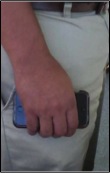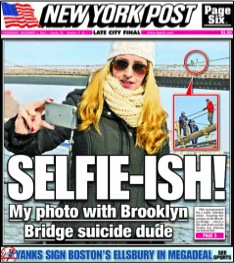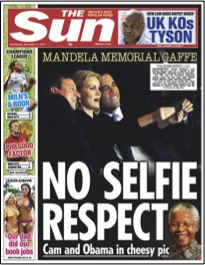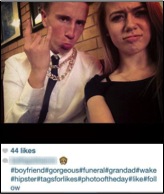(Continued from previous post)
The Studio’s Gendered Working Practices
Restating Gender Stereotypes
In retrospect I can see clearly how the majority of practices at the studio upheld the dominant cultural gender norms. At the time, I was shooting people a certain way because it ‘worked’, but only after I left did I get some sense of perspective on why it ‘worked’.
An example of this is what we called the Harmony shoot, a session designed for couples. A typical Harmony would involve a number of poses designed to show the romantic closeness between the couple: they would hug, lie side by side, sit lying against each other and so on. But these poses had a number of underlying principles of organisation: the man would stand behind the woman with his arms round her, never the other way round. The woman would usually stand a little forward of the man, making her the focus of the image. If only one person had eye contact with the camera, it would be the woman. If anyone was lying down rather than sitting, it would be the woman.
Many of these poses would rely upon the couple conforming to certain gender stereotypes: the woman being more feminine than the man, and the woman being the more flamboyantly dressed and therefore happy to be the centre of attention. But most importantly, the woman must be smaller than the man. Size relations were so important that if they were reversed, we simply didn’t have a repertoire of poses available. One memorable Harmony of mine was a couple in which the woman was significantly taller and broader than her male partner. I struggled to find any poses that didn’t appear somehow mocking – him hugging her from behind looked ‘wrong’ and comedic, but not as wrong as her hugging him from behind. I eventually settled on a number of seated close-ups and was relieved when the shoot ended.
The principles that made a photograph “work” depicted gender relations and characteristics as natural and effortless. Anything that looked forced or that made the stereotype look wrong, such as the woman taller than her partner, was problematic and required bringing into line, or disguising.
Posing Women
After reading Erving Goffman’s Gender Advertisements, I saw that the majority of the poses and assumptions I was working with at the studio could be directly linked to similar manifestations in advertisements. Goffman describes the slightly bent knee, the canted head, and the expressions of distraction or ‘flooding out’ in happiness or excitement – all common in the field of portrait photography. His description of women’s hands in adverts rang particularly true to me – hands that are relaxed and barely touching the face, the body or another hand are common in adverts and portraits alike (Goffman 1979). They do not grasp or point, and are definitely not for leaning on, but provide a frame for the face, or continue the graceful arc of the arm.
The studio handbook for new photographers reproduced images which were considered examples of good practice. Categories of poses would be grouped together – poses which make the woman look vulnerable and unthreatening were labelled ‘pretty’, with their edgier counterparts (the strong stance, the confrontational gaze) being ‘street’ or ‘sexy’. Common crops would be either very close, suggestive of intimacy, or quite distant, with space off to the side for the client to gaze into.
The studio handbook specifies:
“Good poses will make the client look confident and sexy even if they aren’t”
“Try to make most of the client’s best features (nice legs, sexy shoulders) and hide problem areas (big tummy, big arms)”
“Poses should look natural and relaxed, or strong and dynamic”
“Try to make the pose suit the age, clothes and attitude of the client”
Natural Shots
A large proportion of clients wanted ‘natural’ or ‘traditional’ shots – fairly even lighting, neutral backgrounds and simple seated poses. These were often the hardest photographs to get right, as achieving the correct level of ‘naturalness’ whilst concealing the overall artifice involved in making it, was quite difficult. Naturalness in this case meant obscuring the means by which the photograph was produced – the make-up should be barely there, the hair should be styled but not obviously so, the clothes should be that puzzling concept ‘smart-casual’.
But a natural expression or pose has been coaxed from the client just like any other, then managed and modified to flatter and enhance. The concealment of the process was paramount for these clients – if the end results reflect the fact that they were produced during a carefully choreographed photoshoot, rather than the spontaneous outcome of some lighthearted snapping, then they would be rejected. More artifice was needed to conceal their ‘fakeness’.
This emphasis on naturalness as a desirable performance of femininity is a dominant feature of makeover programmes such as Snog Marry Avoid. Here, the female contestant is chastised vigorously for her exaggerated (and playful) embodiment of femininity – long nails, fake tan, hair extensions and so on. A transformation into the ‘natural’ alternative is performed on the woman, to the approval of her family and friends. That the ‘natural’ version requires hair dyes, make-up and new clothing as much as any other look seems to escape the participants’ and presenter’s notice.
This tyranny of the natural look is particularly unpleasant in that it demands a good deal of maintenance and expenditure, but that this means of production be invisible. Angela McRobbie describes the class connotations underpinning the makeover format, as well as the relationship between taking fashion advice and a more general readiness to submit to external authority about behaviour and appearance.
In contrast to glamour’s gendered marker of working- or lower-middle class, the simple chic favoured by middle-class women implies that there was no need for labour, anxiety or planning in creating their appearance. Glamour has a problematic place within women’s lives, in that there are contradictory cultural values associated with it, that both condemn and congratulate identical behaviours.
Sexy Shots
Unsurprisingly, by far the most predominant theme was sexual attractiveness. Women were posed draping themselves over glitterballs, rubbing up against walls, leaning forwards with hand on hip, with a frequent look off to one side as if feigning ignorance of the fact that they were being looked at. They would stand with legs apart and hand in hair, sometimes facing a fan to simulate some sort of breeze as they stared off into the distance.
For the younger and more fashion-conscious clients, strange and awkward poses would be struck – as if caught falling, broken or flinching – in direct replication of the adverts for clothing and perfume that drifted around the minds of both photographer and client. They would lie on the floor staring wistfully at the camera, sometimes with their legs up against a wall to be better displayed. Hair would be arranged to look artfully tousled on the floor around their faces. The position on the floor troubled me, being the most submissive and vulnerable place, and yet somehow also the most popular. Perhaps, like the other poses, it chimed with some stereotype in the collective consciousness and therefore “worked” – woman to be looked down on, woman looking away, woman as available, even whilst being a mystery.
There was a small room off to one side called ‘the Boudoir’ where ‘sexy’ shots could be taken in private, usually in the dark with just one spotlight. Much of the ‘glamour’ side of the work made me uneasy, as the client requesting such shots sometimes did not appear entirely comfortable. Someone who had been chatty and relaxed in the more casual shots, might then become quiet and visibly nervous once in their underwear. This change in attitude is of course understandable, but I could not help but question (to myself) why they were doing it. Was it because they wanted to show confidence in their body? Was it to complete a range of shots from casual to sexy? Was it to satisfy the request of a partner? Or was it because this depiction of themselves, this extreme femininity, was highly prized – evidence that they too could be heterosexy (as Amy Shields Dobson refers to a specific type of male-oriented femininity)?
Men
Men were not depicted lying on the floor, or with their legs up against the wall. There was rarely the same sense of display. A ‘sexy’ pose for a man might just involve sitting in a suit, leaning against a wall, or being shot from below to exaggerate height. Overall, men’s shoots were much simpler than women’s, as the range of poses was vastly reduced. Sometimes I would forget myself and accidentally ask a man to do a woman’s pose – hand on hip, for example – but the mistake would be immediately visible and felt by the client to be wrong.
The fussy, overstyled approach to photographing a woman was not suitable for a man, whose personality and ‘look’ could supposedly speak for itself. Women had a multiplicity of looks at their disposal, a huge variety of outfits and poses in comparison with men. This reduced need for embellishment suggests some sort of universal essence that the men could tap into, and which needed little elaboration in order to become visualised.
The Keycard
The keycard was a list of available ‘styles’ of photography that the client could choose from, illustrated with examples. The most popular categories were pretty, casual and classic. The main change between the three was the lighting, as the poses remained largely similar. Pretty lighting was soft and romantic with coloured gels; casual lighting was simple and uncoloured; and classic lighting emulated the deep shadows and chiaroscuro effect of oil paintings.
The stereotypical posing and lighting, and the categories of style presented on the keycard, “worked” for the client by fitting in with their innate sense of taste / habitus. By reinforcing the habitus, these images helped the subject perform what is required of them as a social entity, shaping behaviour and disposition. McRobbie paraphrases Judith Butler by stating that the habitus is the space for the generation of social belief in the obviousness of dominant social reality (McRobbie 2009): in this case, gendered behaviours and appearances.
On the reverse side of the card appeared examples of retouching, mostly a variety of montages. By far the most popular request for the retouchers was the addition of wings. Completely contradictory instructions were common, such as ‘I want to look natural and classic, with wings’.
The keycard offered the illusion of choice to the client, whereas every photographer knew that they had one standard shoot that was the same for everyone, with only minor modifications. After only a few months working there, I could already look back and note, with some discomfort, how similar I had made everyone. I could compare dozens of manifestations of the same pose and lighting, with only the face and clothing changing. I wondered how the clients would react to this, seeing just how undifferentiated they were in a process which claimed to harness their individuality.
Partly because of ease, and partly because of the requirement to keep to a brand, my process of photographing someone had become industrialized.
What the studio experience taught me about photography
Although the majority of the photographers at the studio had studied photography at university, the job itself required disengaging with many of the critical or reflective skills learned during our studies. For instance, I would want to ask a client who asked for “natural shots without posing” what it was she meant by “natural”, and have a discussion about artifice, but this was not the context for that and so I went along with what I hoped she meant.
It was quite far removed from what we had come to believe photography could be: a medium for creative self-expression, for revealing a personal truth, for “documenting” and so on. Instead, the studio relied on a predictable and marketable product, emphasising reproducibility of a branded “look” and experience.
Composition
Some of compositional elements of the images require discussion here. Photographers routinely utilised abstract spaces: stairs that lead nowhere, a leather booth in the wall high up from the floor, a simulated brick wall and the ubiquitous ‘circle’ where clients could recline with their legs outstretched. Sometimes we improvised and shot against a heating duct or metal girders to give an ‘industrial’ feel. These spaces, despite being meaningless, were popular with the clients, and imbued their shots with an element of fantasy. Even in the more ‘normal’ settings such as a chair or couch, we encouraged clients to stand on them, or lie provocatively across them – engaging in the fantasy creation by making their behaviours appear unusual or spontaneous.
The Desired Product
The rather romanticised view of portraiture I had previously did not last long under these conditions. The aim of the entire procedure was not some sort of creative engagement with the client in order to produce a personalised set of images. Rather, we worked to the assumption that the majority of clients wanted a variation on a theme – to see themselves inserted into the dominant cultural norms that were manifested all around them in adverts, films, music videos, art galleries and on television. Photography seemed to offer the possibility of participating in the abstracted world of advertising and fashion, and engaging on a level playing field with models and celebrities.
This potential for make believe is of course nothing new, but it was the scale and the cynicism of the replication process that struck me. The portrait industry relies upon the unquestioning reproduction of stereotypes, regarding gender, class, sexuality and race. A ‘good’ shoot would make them look successful at performing the stereotypes – economically secure, sexually desirable and available, and able to perform the roles society requires of them. The improper reproduction of a stereotype would elicit distress or derision in the client – an illustration of the potential discomfort and damage caused by incorrect or unnatural gender performance as described by Butler (1990).
Some questions that this job prompted me to ask:
Is a (portrait) photograph still valid as ‘evidence’?
The rejection of the unflattering image, and the upset which it causes, is familiar to all. The photograph continues to hold enormous evidential significance, despite the break in the indexical link between image and reality consolidated by photo manipulation software. Viewers’ perceptions have not kept up with advances in digital technology or photographic theory. A recent advert for SanDisk memory cards reflects this as it claims to “deliver the proof”- a play on words between proof as evidence and as being protected from something e.g. weatherproof.
Tagg describes the realism of a photograph as being in direct relation to who is looking at it (Tagg, 1988). Despite the creation of meaning in a photograph depending on who’s looking at it, and the viewer’s tacit if not explicit knowledge that the photograph can and does lie, the belief exists that it can embody some essential truth. Portrait manuals continue to speak of ‘capturing the essence of your subject’, ignoring the decades of theoretical argument against such an essence existing.
Why is the portrait industry geared towards women?
The portrait industry is heavily influenced by the language and logic of fashion, and McRobbie’s analysis of fashion photography is very useful in defining its appeal to women. She describes how fashion photography enacts sexual difference anew, but always ultimately in favour of existing gender hierarchies. The viewer desires the freedom that is depicted within the images, but is yet aware of external, constant, constraints (McRobbie 2009).
The seductive message behind fashion photographs is that the viewer, or most importantly the consumer, is an agent of change, endowed with capacity – an appealing idea for the majority of women. Through labour on the self, the viewer can act out the fantasy of the fashion image – that women are not subordinate to men (McRobbie 2009).
The portrait, by extension, becomes a site for site for experiencing a kind of freedom from gender constraints, but one which is, ironically, enacted through heavily proscribed conventions.
What is the appeal of glamorous femininity, as depicted in these portraits?
McRobbie identifies the role that beauty and fashion play in addressing the fraught state of non-identity. The language of pampering and “being worth it” in the advertising and makeover formats encourages women to move to a state of potential worth to consumer culture and the labour market, as well as increasing their own exchange value in what is presented as an increasingly competitive world. In this dramatisation of the individual, it is a requirement not to be overlooked, but to make oneself visible through personal effort and spending (McRobbie 2009).
Through sheer prevalence the specifics of the glamorous/visible look begin to take on a compulsory tone, and it “becomes increasingly difficult to function as a female subject without subjecting oneself to those technologies of self that are constitutive of the spectacularly feminine.” (McRobbie 2009: 60)
McRobbie also describes the excessively feminine masquerade as a cover for the new power being accrued by women in their economic capacity. A certain ‘girliness’ (accessed through the purchase of girly products and services) goes towards alleviating the anxiety that power makes women unfeminine and unattractive to men.
How much change to their appearance do the clients want?
The complaint would often be that the clients did not look like themselves, and that we had done something awkward with them. But equally, the clients did not want to look too much like their everyday selves – a degree of change was required, but this was difficult to predict. If the process worked well, the client could be happily persuaded to pay handsomely for a good photograph. If it did not work well, then the client could get quite upset and angry at having been depicted ‘wrongly’.
So what was the dividing point between recognition and feeling distanced from the depiction of the self? The psychology of guessing how someone wants to appear in a photograph was unquestionably the most difficult aspect of the job, and is where the reliance upon stereotypes became vital.
As a means for enacting change, the allure of the make-over scenario is its narrative of enhancing and revealing of a perfected self. Clients want to see themselves in a different light, to see what potential lies within them if only they could be tended to by professionals. This desire to tap potential ties in with McRobbie’s assertion that women’s encouragement to “make the best of themselves” has economic roots, signally her willingness to enter the job market and do what is required of her. A woman “in control” of her appearance is by proxy in control of herself. Having a well-planned life emerges as a social norm of contemporary, individualised femininity, and absence of this is read as a sign of failure (McRobbie 2009).
The voluntary aspect of the behaviours associated with self-improvement and self-policing hides the reality of patriarchy being still in place, obscuring it with a language of meritocracy and social mobility. That the individual is entirely responsible for their own life-plan ensures that women are still fearful, driven by a need for perfection (McRobbie 2009). Acceptable looks do not just carry social weight in this new world of meritocracy – they also enable economic progress: “appearance and self-expression take on new importance when so many jobs are located in the service sector” (McRobbie 2009: 131).
Referenced Sources
Butler, J., (1990). Gender Trouble: Feminism and the Subversion of Identity. New York: Routledge.
Goffman, E., (1979). Gender Advertisements. London: Macmillan.
McRobbie, A., (2009) The Aftermath of Feminism: Gender, culture and social change. London: Sage.
Tagg, J., (1988). The Burden of Representation: Essays on photographies and histories. London: Macmillan.




